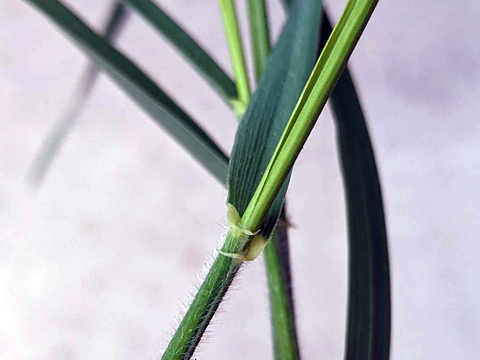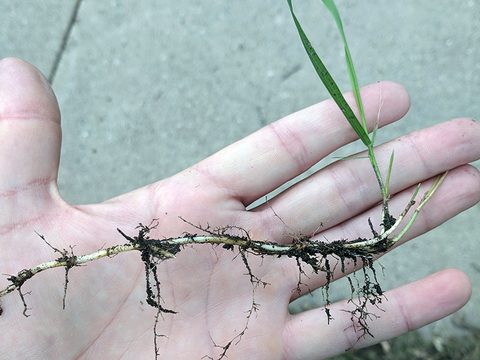Quick facts
- Quackgrass is an aggressive cool-season perennial that spreads primarily by rhizome.
- Quackgrass is on the U.S. Department of Agriculture's restricted noxious seed list.
- Quackgrass grows quicker than most turfgrass and is often identified by its height.
- Applying herbicides is often the most effective method to remove quackgrass.
Characteristics
Quackgrass (Elymus repens), also known as couchgrass, is an aggressive introduced cool-season perennial. This grass is a member of the Poaceae family (grasses) that spreads by seed and rhizomes and is listed by the U.S. Department of Agriculture as a restricted noxious weed seed.
Although quackgrass can grow up to 4 feet high, it is often only several inches tall in lawns. Quackgrass is identifiable from similar-looking grasses by its upright structure, clasping auricle (a claw-like appendage at the base of the leaf that wraps around the stem), and rhizomes.
Flowers, fruit and seeds
- Seed germination time: Early spring
- Seed reproductive time: Spring – Fall
- Quackgrass produces a 2- to 10-inch rounded spike that contains rows of alternating spikelets.
- Each stem can produce 25-40 seeds.
- Although quackgrass reproduces by seed, many are sterile, and most plants are spread primarily by rhizomes.
Leaves
- Alternate leaves grow 2 to 12 inches long.
- Quackgrass has a clasping auricle (claw-like appendage at the base of the leaf that wraps around the stem).
- The underside of the leaves does not have hairs.
- Leaf surfaces may or may not have hairs.
Stem and roots
- Quackgrass produces rhizomes with sharp points that can reach up to 11 feet long.
- The rhizome produces fibrous roots at nodes.
- New plants can be produced from pieces of rhizome.
Where it thrives
- Quackgrass thrives in disturbed soils that range from partly shaded to full sun.
- It adapts to grow in a wide range of environments, but it doesn't grow well in dry regions.
- Quackgrass can indicate high potassium and manganese and low phosphorus and calcium in soils.
- This grass is most commonly found in lawns, meadows and fields.
Control and management
Many researchers believe that quackgrass has allelopathic properties, preventing the growth of other plants through the release of chemicals.
Quackgrass rhizomes can make it difficult to get rid of it completely without repeated attempts.
Turf
- Hand removal is possible but may be difficult due to extensive rhizomes.
- A dense and healthy turf is the best defense against quackgrass encroachment.
- Checking seed mix compositions, sod and using proper composting techniques can prevent quackgrass seeds and rhizomes from entering your lawn.
- Non-selective post-emergent herbicides:
- Glyphosate
- Glufosinate ammonium
- These non-selective post-emergent herbicides kill broadleaf plants, turfgrass and quackgrass.
- Pre-emergent herbicides are not recommended for perennial weeds like quackgrass and may affect desired cool-season turfgrass.
- Existing quackgrass infestations will continue to grow through pre-emergent herbicides because they are perennial.
Garden
- Hand removal is possible but may be difficult due to extensive rhizomes.
- Tillage can often make quackgrass worse by spreading rhizomes.
Benefits to the landscape
Although quackgrass should not be purposely planted in Minnesota, it can effectively reduce erosion and reclaim nutrients in damaged soils. Parts of this grass have also been used to produce chemicals that repel slugs and mosquitos.
Quackgrass provides comparable nutrients to other grasses when used as forage for animals, although less invasive plants can provide equal value.
Quackgrass seeds and roots have been used in parts of Europe as an alternate source of flour during times of famine.
Conservation, invasive status and native status
- Restricted noxious seed.
- Quackgrass is an introduced grass native to Europe and Asia that was likely brought to the U.S. inadvertently through agricultural products in the 1600s-1700s.
- The “quack” in quackgrass derives from the German word queck, meaning lively or quick.
Plants that look similar
- Tall fescue
- Smooth brome
- Ryegrass
- Crabgrass
CAUTION: Mention of a pesticide or use of a pesticide label is for educational purposes only. Always follow the pesticide label directions attached to the pesticide container you are using. Be sure that the area you wish to treat is listed on the label of the pesticide you intend to use. Remember, the label is the law.
Cornell University. Quackgrass. Cornell College of Agriculture and Life Sciences. https://cals.cornell.edu/weed-science/weed-profiles/quackgrass#:~:text=Reproduction%3A%20Quackgrass%20reproduces%20both%20vegetatively,(Werner%20and%20Rioux%201977)
Duval, J. Quackgrass (Elytrigia repens) control methods in organic agriculture. Got Pests? https://www.maine.gov/dacf/php/gotpests/weeds/factsheets/Quackgrass-organic.pdf
The Ohio State University. Quackgrass (Elymus repens). Ohio Perennial and Biennial Weed Guide. https://weedguide.cfaes.osu.edu/singlerecord.asp?id=115
Sandborn, D. (2016, August 15). Weeds are an indicator of a soil’s health. MSU Extension. https://www.canr.msu.edu/news/weeds_are_an_indicator_of_a_soils_health#:~:text=Signs%20of%20soil%20deficiencies%3A&text=It%20also%20indicates%20a%20soil,of%20improper%20iron%2Dmanganese%20ratio
Reviewed in 2024




